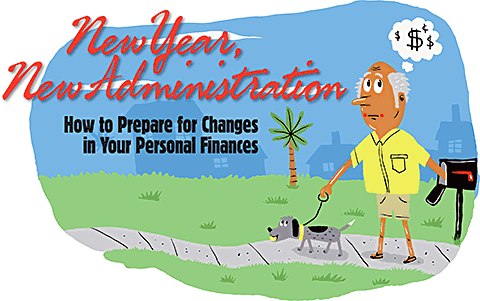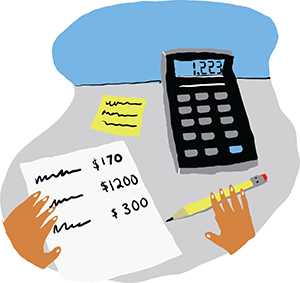 |
|||||||||
|
January/February 2017
BY SCOTT BERMAN With a new administration, many changes are afoot. While nothing is definitive, it is clear that areas of your personal financial life will be affected. Because knowledge is power, the best way to prepare is to understand what could happen, what you use and consume, what your current situation is, and what’s important to you. Let’s take a look at each of these elements dealing with health care, taxes, interest rates, and inflation.
President Trump and the GOP have vowed to dismantle the Affordable Care Act and replace it with an alternative. As I write this, their current plan is to pass a bill that would repeal many key provisions of the law. Under this scenario, federal funds that have allowed states to expand their Medicaid safety nets would be cut, as would subsidies to low- and middle-income Americans that offset the cost of insurance premiums. Medicare also may be affected. For years, House Republicans have wanted to shift Medicare away from its open-ended commitment to pay for medical services and toward a fixed government contribution for each beneficiary. In addition, Republicans would allow Medicare recipients to choose from private insurance plans as well as traditional Medicare. They will likely push forward with this plan in 2017. What to review:
Effective marginal income tax rates on wages and salaries would be reduced by about two percentage points, on average. The top 0.1 percent of earners would see a cut of over seven percentage points, but those with the lowest incomes would see less than a one-percentage-point cut. However, millions of middle-class working families will see their tax bills rise—especially single-parent families. The increase is due to the proposed elimination of the $4,000 exemption for each person in a household. What to review:
Though a presidential administration doesn’t directly influence interest rates or inflation, it’s important to look at interest rates and inflation, because changes in both affect every single American. First, a primer on interest rates and inflation, which are closely linked. When one goes up, the other goes down. For example, when interest rates are low, more people can borrow money. The more money they have, the more they spend. An increase in spending causes the economy to grow and inflation (the increase in the cost of goods and services) to increase. When interest rates are high, the opposite happens.
And indeed, the economic data have been positive. The U.S. has added jobs for seventy-four consecutive months, the unemployment rate has fallen to 4.6 percent (the lowest since 2007), and the economy has expanded for seven years (slowly but steadily). Inflation also will likely kick up and be higher than we’ve seen in the last few years. From 2006 to 2016, inflation has averaged 1.6 percent annually, a very low figure. Mark Sniderman, an economist at Case Western Reserve University, has predicted that inflation could rise to 2.5 percent in 2017 and 2.75 in 2018 based on expectations that the economy will continue to strengthen. While not a huge increase, it will make the cost of everything—from toilet paper to motorcycles—go up. What to review:
Scott Berman is a financial adviser in North Bethesda, Md., specializing in individual, family, and small-business-owner financial planning. His email address is scott.berman@coliseumwealth.com |
|||||||||
|
|
|||||||||
The Military Working Dog Commemorative Stamp Drive needs your help. |
|||||||||
8719 Colesville Road, Suite 100, Silver Spring. MD 20910 | www.vva.org | contact us |
|||||||||






















 Trump has proposed a tax plan that includes only three tax brackets (there are currently seven) and repeals the head-of-household tax-filing category. The standard deduction would be $30,000 for married couples filing jointly (up from $12,600 currently) and $15,000 for single individuals (up from $6,300).
Trump has proposed a tax plan that includes only three tax brackets (there are currently seven) and repeals the head-of-household tax-filing category. The standard deduction would be $30,000 for married couples filing jointly (up from $12,600 currently) and $15,000 for single individuals (up from $6,300). In December the Federal Reserve raised the interest rate 0.25 percent for the second time in 2016, because as Janet Yellen, the Fed’s chair stated, “Economic growth has picked up since the middle of the year. We expect the economy will continue to perform well.”
In December the Federal Reserve raised the interest rate 0.25 percent for the second time in 2016, because as Janet Yellen, the Fed’s chair stated, “Economic growth has picked up since the middle of the year. We expect the economy will continue to perform well.” Spend an hour or two adding up your current monthly or yearly expenses in each of these areas so you know what you’re spending now. Then compare those numbers with expected increases or decreases next year and two, three, and four years out. Once you understand where you are today and list expected needs, you’ll be better prepared to handle whatever changes may occur.
Spend an hour or two adding up your current monthly or yearly expenses in each of these areas so you know what you’re spending now. Then compare those numbers with expected increases or decreases next year and two, three, and four years out. Once you understand where you are today and list expected needs, you’ll be better prepared to handle whatever changes may occur.